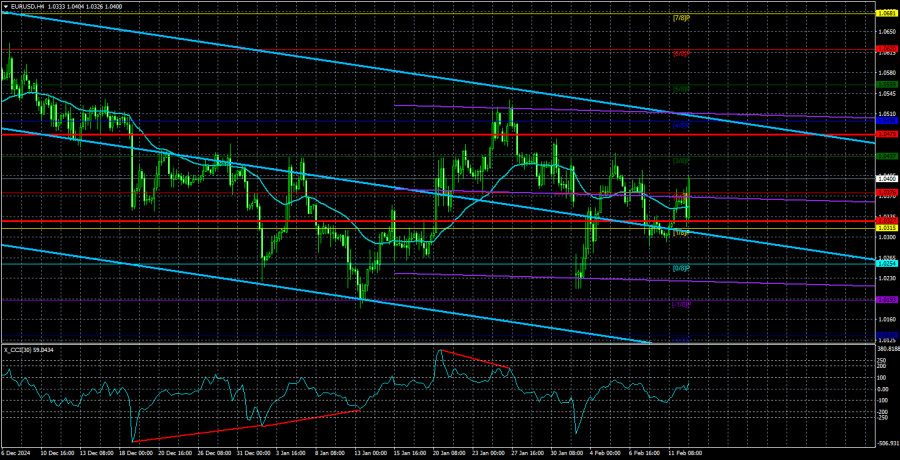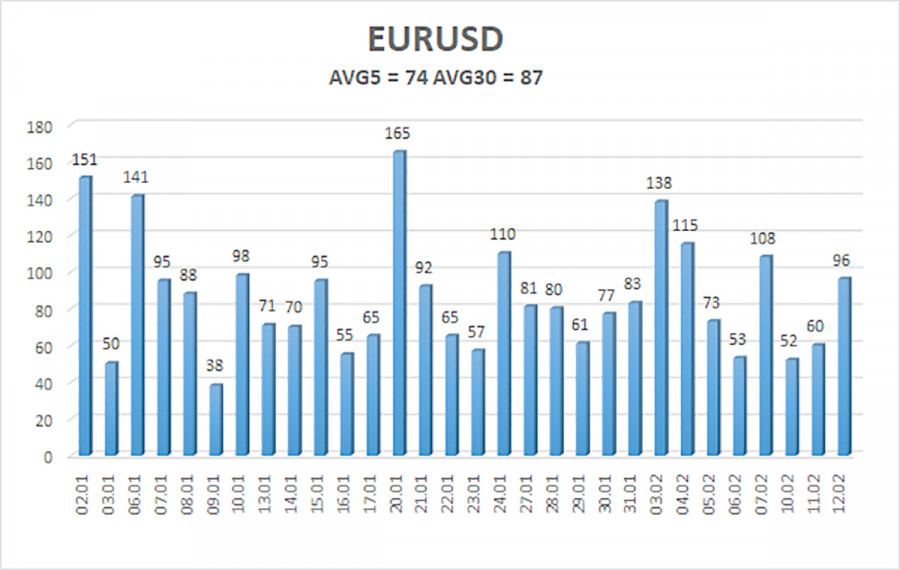The EUR/USD currency pair continued to trade calmly on Wednesday. Analyzing the 4-hour timeframe, it's evident that the price is contained within a triangle pattern, gradually consolidating before a potential breakout. Volatility is decreasing, and the price fluctuates without consistently responding to macroeconomic or fundamental factors.
Currently, technical factors are paramount. Firstly, the pair remains in a correction phase on the daily timeframe, which leads us to anticipate a stronger upward movement, even in the absence of fundamental or local reasons to support it. Secondly, the 4-hour chart shows that the pair has been moving sideways for an extended period. Lastly, the hourly chart reveals a series of rapidly changing alternating trends, indicating that strong trend movements are not expected at this time.
On Tuesday and Wednesday, Jerome Powell delivered two speeches before the U.S. Congress. Some traders had high expectations for these events; however, the Federal Reserve Chair did not offer any new insights for the market or Congress members. He reiterated his previous message, emphasizing the strength of the U.S. economy, the stability of the labor market, and the persistence of elevated inflation. These factors justify keeping the key interest rate unchanged in the near future.
Many had anticipated that senators would question Powell about Donald Trump's influence on the Fed's monetary policy decisions. However, this topic was never raised. This is not surprising, as it is primarily the media, rather than politicians, that focus on this issue—especially since many lawmakers align politically with Trump.
As a result, Powell was not compelled to address whether Trump's demand for lower interest rates could sway the Fed's stance. Nonetheless, he indirectly tackled the issue by emphasizing that monetary easing is not planned in the near future. He also mentioned that the Fed would consider resuming rate cuts only if inflation slows down or if the labor market weakens significantly. Currently, neither condition is being met. The NonFarm Payrolls report consistently shows strong results, the unemployment rate has been declining for two consecutive months, and inflation has been rising for three months straight.
Thus, Powell's speeches in Congress reinforced the notion that the U.S. dollar could continue to strengthen. We still expect the EUR/USD pair to undergo a deeper upward correction, which could last for several more weeks or possibly even months. However, once this correction is complete, we will be looking for a renewed sharp decline in the euro, unless there is a dramatic change in the fundamental landscape in the meantime.
The average volatility of the EUR/USD currency pair over the last five trading days as of February 13 stands at 74 pips, classified as "medium." We expect the pair to move between 1.0327 and 1.0475 on Thursday. The higher linear regression channel remains downward-oriented, indicating that the global downtrend persists. The CCI indicator previously entered the oversold zone and has begun a new ascent from the bottom.
Nearest Support Levels:
S1 – 1.0376
S2 – 1.0315
S3 – 1.0254
Nearest Resistance Levels:
R1 – 1.0437
R2 – 1.0498
R3 – 1.0559
Trading Recommendations:
The EUR/USD pair sharply resumed its downward movement before quickly retracing upward. For months, we have consistently stated that we expect only a decline in the euro in the medium term, and this outlook remains unchanged. The Fed has paused its monetary easing, while the European Central Bank, on the contrary, is accelerating it. The U.S. dollar still has no fundamental reasons for a sustained medium-term decline except for purely technical and corrective factors. Short positions remain far more attractive, although a technical correction may continue.
If you trade based solely on technical analysis, long positions can be considered if the price consolidates above the moving average, targeting 1.0437 and 1.0475. However, any upward movement is still classified as a correction on the daily timeframe.
Explanation of Illustrations:
Linear Regression Channels help determine the current trend. If both channels are aligned, it indicates a strong trend.
Moving Average Line (settings: 20,0, smoothed) defines the short-term trend and guides the trading direction.
Murray Levels act as target levels for movements and corrections.
Volatility Levels (red lines) represent the likely price range for the pair over the next 24 hours based on current volatility readings.
CCI Indicator: If it enters the oversold region (below -250) or overbought region (above +250), it signals an impending trend reversal in the opposite direction.













